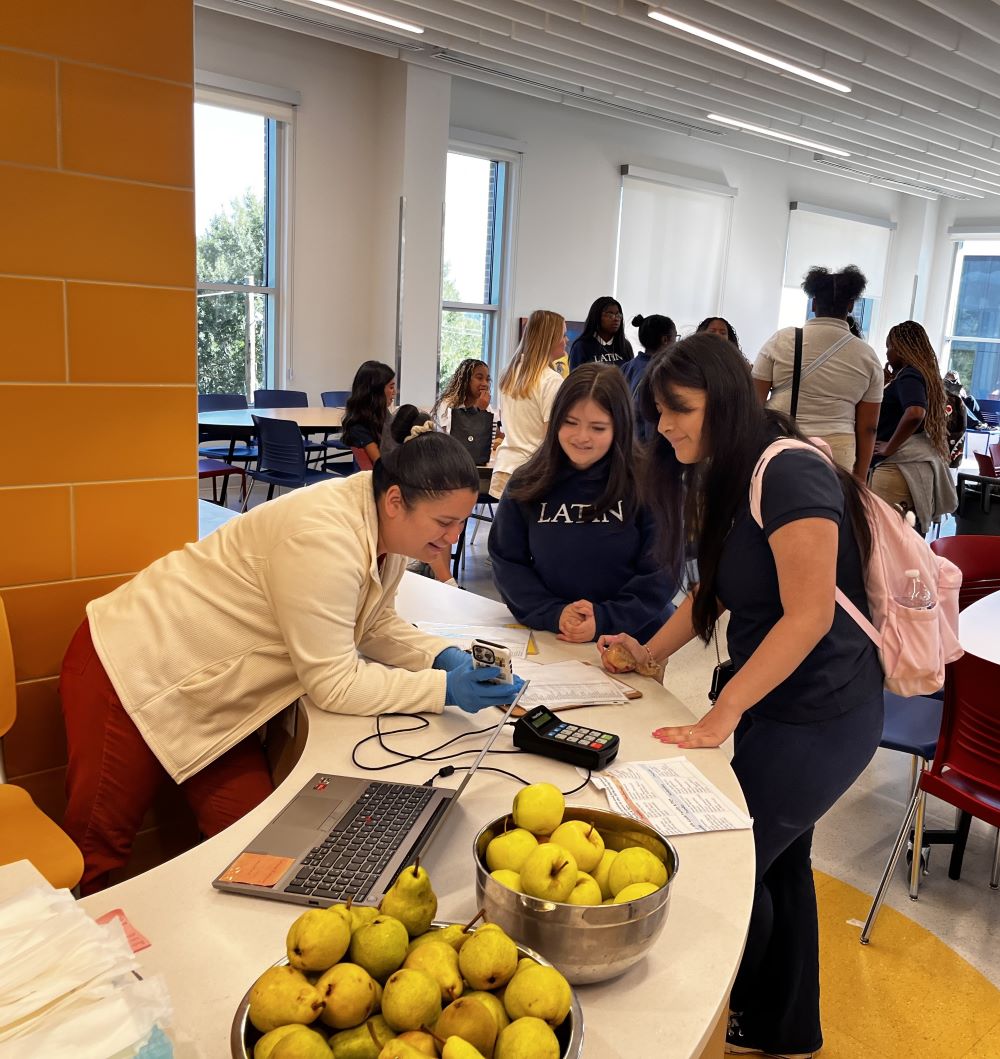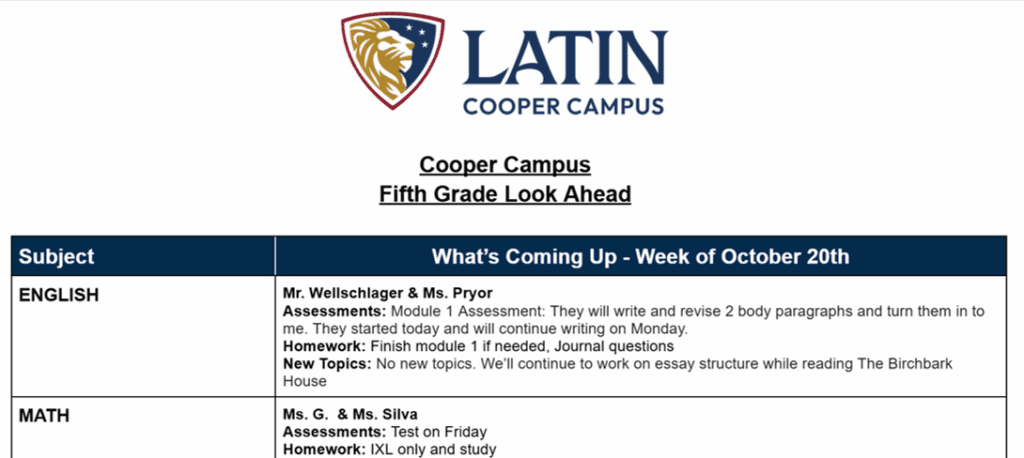ገላጩ፡- ይህን በቀለማት ያሸበረቀ ፍርግርግ እንዴት አነባለሁ?
ቤተሰቦች ብዙውን ጊዜ ስለ ፕሮግራማችን ይጠይቃሉ, ይህም በመጀመሪያ ሲታይ ውስብስብ ይመስላል. ለዚህ የእኛ ምክንያቶች አሉን! ይህ ገላጭ የጊዜ ሰሌዳውን እንዴት እንደሚያነቡ እና ለምን እንደሚመስል ይመራዎታል።
- በአማካሪነት እንጀምራለን- የአማካሪ ስርዓታችን የላቲን መንገድ ማዕከላዊ ነው። ይህ ለእያንዳንዱ ተማሪ መነሻ ነው፣ እና በተጨማሪ፣ ለቤተሰቦቻችን አስፈላጊ ግንኙነት። የእኛ አማካሪዎች የጋራ መተሳሰብ፣ ማህበረሰብ እና ለአማካሪዎቻቸው አስደሳች ስሜት ያሳድጋሉ። ይህ ተማሪዎቻችን በየእለቱ ጥዋት የዴይሊ ቡለቲንን ለመስማት እና ለእለቱ የሚዘጋጁበት ነው። በተጨማሪም በየሳምንቱ እሮብ ከዚህ አነስተኛ ማህበረሰብ ጋር ሳምንታዊ የምክር ምሳዎች አሏቸው። በአማካሪ ላይ ያለውን ገላጭ ያንብቡ
- መርሃግብሩ ሰባት የተሰየሙ የክፍል ጊዜያት አሉት - ወቅቶችን በፊደል (ኤ ወይም አልፋ) እንጠራዋለን እና ሰባቱን በየቀኑ እና ምክር፣ እረፍት/እረፍት እና ምሳ እንይዛለን። በእያንዳንዱ ቀን መጨረሻ (ሰኞ - ሐሙስ)፣ ተማሪዎች ከማንኛቸውም መምህራኖቻቸው እርዳታ የሚሹበት፣ ጥያቄዎችን የሚያዘጋጁበት ወይም በፕሮጀክት ላይ የሚሰሩበት አማራጭ የማጠናከሪያ ጊዜ [LINK] አለን።
- ኤ (ወይም አልፋ) አይደለም። ሁልጊዜ የመጀመሪያ ጊዜ - A ፊደል ይጀምራል፣ ነገር ግን A ወይም Alpha ሁልጊዜ የመጀመሪያ ጊዜ አይደሉም፣ ወይም ሁልጊዜ B ወይም ቤታ ጊዜ አይከተሉም። ትኩስ እንዲሆን ለማድረግ እና ተማሪዎች አንድን ርዕሰ ጉዳይ ከተወሰነ የቀን ሰዓት ጋር እንዳያያይዙት የክፍላችንን ክፍለ ጊዜ ቅደም ተከተል እንቀይራለን። ለምሳሌ፣ ሒሳብ ሁልጊዜ የመጀመሪያ የወር አበባ ከሆነ፣ የጠዋት ሰው ያልሆነ ተማሪ ትምህርቱን ከዝቅተኛ ጉልበት ጋር ለማያያዝ ሊመጣ ይችላል። ይህንን ለማስቀረት, ወደላይ እንቀይራለን.
- እያንዳንዱ ክፍል በሳምንት አራት ጊዜ ይሰበሰባል- ተማሪዎች ሳምንቱን ለመጀመር እና ለመጨረስ (ሰኞ እና አርብ) እያንዳንዱን መምህራኖቻቸውን ይመለከታሉ። ማክሰኞ፣ እሮብ እና ሐሙስ፣ ለፕሮጀክቶች እና ለውይይት የተሻሉ፣ ረዘም ያለ ጊዜ ይኖራቸዋል። ያንን ተጨማሪ ጊዜ ለማግኘት ከመርሃግብሩ ላይ አንድ ጊዜ እንጥላለን።
- ምሳ እና እረፍት ወይም እረፍት የተለያዩ ወቅቶች ናቸው- ተማሪዎች ለአመጋገብ፣ ለሲቪል ውይይት እና ለአካል ብቃት እንቅስቃሴ እና ለማህበራዊ ጨዋታ ጊዜ ማግኘታቸው አስፈላጊ ነው ብለን እናምናለን። እያንዳንዳቸው እነዚህ ተግባራት በየእለቱ መርሃ ግብር ይለያያሉ, ብዙ ልጆች በፍጥነት የመብላት ዝንባሌን በማስወገድ እና በእረፍት ጊዜያቸውን ያሳድጋሉ.
- አንዳንድ ጊዜ ማክሰኞ ሰኞ መርሃ ግብር ነው - ወደ ውስብስብነቱ ስንጨምር፣ አንዳንድ ጊዜ የትኛውን ቀን እንደምንከተል እንቀይራለን። ለምሳሌ፣ ሰኞ በዓል ካለ፣ ርእሰ መምህሩ ተማሪዎች የሰኞ መርሃ ግብራቸውን ማክሰኞ እንዲከተሉ ሊወስን ይችላል (ስለዚህ ሁሉም ክፍሎቻቸው እንዲኖራቸው)።
ይህ በሳምንታዊ መርሃ ግብሩ ውስጥ የታጨቀ ብዙ መረጃ ቢሆንም፣ ስለ ተማሪዎቻችን መጨነቅ የለብዎትም፡ መርሃ ግብሩን በፍጥነት ይማራሉ!
የዘንድሮውን መርሃ ግብር በካምፓስ ገፅ በካላንደር ፍርግርግ ስር ታገኛላችሁ!


